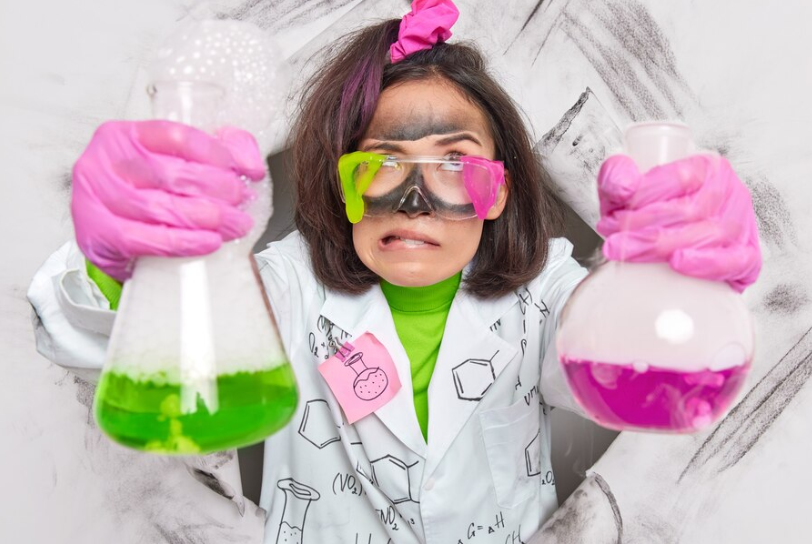AP Chemistry Unit 4 Overview: Mastering Chemical Reactions
Written by SlyAcademy
Table of Contents
- Understanding Chemical Reactions
- Big Idea Questions
- Introduction to Reactions (4.1)
- Net Ionic Equations (4.2)
- Representing Reactions (4.3)
- Physical vs. Chemical Changes (4.4)
- Stoichiometry and Reaction Quantification (4.5)
- Understanding Titration (4.6)
- Types of Chemical Reactions (4.7)
- Deep Dive into Acid-Base Reactions (4.8)
- Oxidation-Reduction (Redox) Reactions (4.9)
Understanding Chemical Reactions
Chemical reactions are at the heart of AP Chemistry Unit 4, and they form the foundation for many processes we see and use daily. This unit dives deep into the rearrangement of atoms, formation and breaking of chemical bonds, and the creation of new substances with unique properties. Mastering this unit is key to success in subsequent topics and accounts for 7-9% of the AP Chemistry exam. Let’s explore what makes this unit essential!
Big Idea Questions
- What makes fireworks explode?
- Why is the mass of a raw egg different than a boiled egg?
- What are the processes related to changes in a substance?
Introduction to Reactions (4.1)
Chemical Reactions are transformations that involve the rearrangement of atoms. Here are the basic types of reactions:
- Synthesis Reactions: Combine simpler molecules into a complex one.
- Decomposition Reactions: Break down complex molecules into simpler ones.
- Combustion Reactions: Hydrocarbons react with oxygen to form carbon dioxide and water, releasing energy.
- Replacement Reactions:
- Single Replacement: An element replaces another in a compound.
- Double Replacement: Exchange of ions between compounds forms new products.
Net Ionic Equations (4.2)
In AP Chemistry, most reactions occur in aqueous solutions, meaning ions interact freely. Net Ionic Equations show only the participating species, leaving out spectator ions. Learning to write these equations with solubility rules is essential for accurately representing reactions.
Representing Reactions (4.3)
To track changes in chemical reactions visually, we use balanced equations that adhere to the law of conservation of mass—matter cannot be created or destroyed. Balancing equations ensures the number of each element remains constant before and after a reaction. Practice makes perfect here!
Physical vs. Chemical Changes (4.4)
- Chemical Changes: Involve the breaking/forming of bonds and the creation of new substances. Examples include combustion and synthesis reactions.
- Physical Changes: Involve changes in states or appearance without changing chemical composition. Examples include freezing or dissolving substances.
Stoichiometry and Reaction Quantification (4.5)
Stoichiometry involves quantifying reactants and products in a reaction. It may feel math-heavy initially, but with practice, you’ll master analyzing reactants and predicting product amounts—an essential skill in chemistry.
Understanding Titration (4.6)
Titrations help determine unknown solution concentrations. During an acid-base titration, adding a known titrant to an analyte causes a color change at the endpoint, while the equivalence point represents equal mole quantities. Titrations are a fundamental technique for quantifying reactions.
Types of Chemical Reactions (4.7)
- Precipitation Reactions: Soluble reactants form an insoluble product.
- Acid-Base Reactions: Involve the transfer of a proton from acid to base, using Brønsted-Lowry definitions (acids donate protons, bases accept them).
- Redox Reactions: Involve the transfer of electrons between molecules, changing oxidation states.
Deep Dive into Acid-Base Reactions (4.8)
In acid-base reactions, acids donate protons while bases accept them. Using the Brønsted-Lowry definition helps clarify the transfer process, represented in equations showing hydrogen ion movement.
Oxidation-Reduction (Redox) Reactions (4.9)
Redox reactions focus on electron transfer. An atom or molecule that loses electrons is oxidized (increases oxidation state), while one that gains electrons is reduced (decreases oxidation state). Balancing redox reactions is crucial for understanding complex reaction mechanisms.
Conclusion
Mastering chemical reactions provides a strong foundation for understanding the complexities of AP Chemistry. By focusing on reaction types, stoichiometry, net ionic equations, and reaction mechanisms, you will be well-prepared for both exams and real-world applications.
Dive deeper, practice consistently, and gain confidence in your chemistry knowledge!







